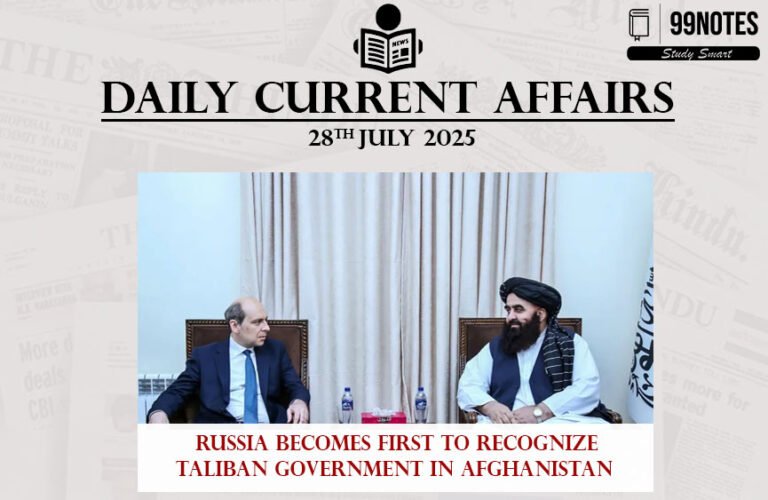1 Dec 2023 : Daily Current Affairs
Daily Current Affairs
1-December-2023
1. GDP surges 7.6% in Q2, goes past RBI forecast
Topic: GS3 – Indian economy.
Context:
- India’s GDP grew at a higher-than-expected rate of 7.6% in the July-September 2023 quarter.
- The growth surpassed the central bank’s projection of 6.5% despite tangible downturns in the farm and services sectors and consumer spending.
Comparison with Previous Quarter:
- Q2 growth was slightly lower than the 7.8% recorded in the previous quarter but exceeded expectations.
- The Gross Value Added (GVA) in the economy eased slightly to 7.4%, down from 7.6% in Q1.
Sectoral Performance:
- The farm sector’s GVA growth sharply declined to 1.2% from 3.5% in Q1.
- Services sectors like trade, hotels, and transport saw GVA growth more than halved from 9.2% in Q1 to 4.3% in Q2.
First Half Performance:
- The first half of 2023-24 recorded a provisional GDP growth of 7.7%, with GVA rising by 7.6%.
- Construction saw a significant boost with a 10.5% growth, while manufacturing recorded a 9.3% uptick.
Expectations for Second Half:
- While growth is anticipated to moderate in the second half of the year, economists predict that the strong first-half performance could lift the full-year GDP by 0.1% to 0.2% over current projections.
- Both the RBI and the government expect the full-year GDP growth to be 6.5%.
Economic Outlook:
- Economists estimate annual growth at 6.7%, considering the RBI’s expectations for Q3 and Q4 GDP growth at 6% and 5.7%, respectively.
- The strong first-half numbers contribute to a positive economic outlook despite sector-specific challenges.
2. Understanding simultaneous elections
Topic: GS2 – Indian polity.
Context:
- In September, the Union Government notified a six-member panel to examine and make recommendations for holding simultaneous elections in the Lok Sabha, State assemblies, and local bodies.
- The panel is tasked with proposing specific constitutional amendments and legal changes for simultaneous elections.
Historical Context:
- The first four general elections in India involved simultaneous elections for the Lok Sabha and State Assemblies.
- Subsequent bifurcation occurred due to the advancing of Lok Sabha elections by the Congress in pursuit of a majority after a split in 1969.
BJP’s Push for Simultaneous Elections:
- The BJP has advocated for simultaneous elections since coming to power in 2014.
- NITI Aayog supported the proposal in 2017, and it was mentioned in President Ram Nath Kovind’s address to Parliament in 2018.
Arguments in Favor:
- Cost Savings: Simultaneous elections would reduce recurring expenditure for both the State and Central governments, streamlining the use of security forces and officials.
- National Security Concerns: The prolonged electoral cycle strains security and police forces, impacting national security and law and order.
- Development Impact: Separate elections hinder development as the code of conduct halts ongoing projects, and populist schemes burden the state exchequer.
- Reduced Role of Money: Simultaneous elections would lessen the role of money in campaigns, with more effective monitoring by the Election Commission.
Arguments Against:
- Federal Spirit Concerns: Critics view the initiative as antithetical to the federal spirit, lacking wider consultation with States.
- National Constituency Phenomenon: Simultaneous elections may sideline local and regional issues, favoring polity-wide parties over regional ones.
- Cost Considerations: Large-scale procurement of Electronic Voting Machines (EVM) and Voter Verifiable Paper Audit Trail Machines (VVPAT) would be required.
- Voter Enthusiasm and Accountability: Frequent elections keep voters engaged, contributing to higher turnout and increased accountability of elected representatives.
Legal and Constitutional Issues:
- Amendments Required: At least five articles in the Constitution need amendment to enable simultaneous elections.
- Complex Process: Amendments require two-thirds majority support in both Houses of Parliament and ratification by at least half of the State Legislatures under Article 368.
- Link to Local Bodies Elections: Linking general elections with local bodies elections poses additional complexity due to State-specific legislation.
Challenges and Future Steps:
- Focus on Lok Sabha and Assembly Elections: Given the complexity, the primary focus is likely on synchronizing Lok Sabha and Assembly elections.
- Judicial Review: Proposed amendments may face challenges in judicial review due to their impact on Centre-State relations.
- Consultation Needed: Wider consultation across political parties and States is necessary for any feasible solution.
Conclusion:
- The simultaneous elections proposal requires careful consideration, with the need for comprehensive amendments and collaboration among diverse stakeholders.
Question:
- Discuss the merits and challenges associated with the proposal for simultaneous elections in India, considering constitutional, federal, and logistical aspects. Suggest viable solutions to address the complexities involved.
3. Navy gets ready for its biggest naval exercise amid ocean engagements
Topic: GS3 – defence sector.
Exercise Milan 2024:
- Scheduled for February 2024.
- Anticipates participation from over 50 countries.
- Reflects Indian Navy’s expanded engagements and capacity in the Indian Ocean Region (IOR).
Indian Navy’s Multilateral Engagements:
- Conducts 17 multilateral and 20 bilateral exercises annually.
- Enhances operational capabilities, fosters interoperability, and strengthens diplomatic ties.
- Demonstrates India’s naval prowess and commitment to maritime security.
Combined Maritime Force (CMF):
- India joined CMF in July 2022, a U.S.-led multinational naval partnership.
- Aims to promote security, stability, and prosperity in the IOR.
- Indian naval assets deployed for CMF-led operations regularly.
Navy Day 2023:
- Celebrated on December 4 at Sindhudurg Fort.
- Operational demonstration includes 20 warships, 40 aircraft, and combat beach reconnaissance.
- Honors the Navy’s 1971 India-Pakistan War attack on Karachi harbour under ‘Operation Trident.’
Maritime Capacity Building and Outreach:
- India provides assistance in capacity building to regional countries.
- Deployment of Mobile Training Teams (MTT) overseas for capacity development.
- Over 15,000 personnel from 40 IOR countries trained by the Indian Navy.
Mission Based Deployments:
- Indian Navy’s presence and operational reach expanded through Mission Based Deployments.
- Demonstrates India as the first responder and Preferred Security Partner in the IOR.
Exercise Milan Background:
- Biennial multilateral naval exercise started in 1995.
- Largest exercise conducted by India.
- Strengthens operational capabilities, builds mutual trust, and contributes to maritime security.
4. Three anti-submarine warfare ships for Indian Navy launched
Topic: GS3 – defence sector.
Context:
- Cochin Shipyard Ltd. launched the first three of eight anti-submarine warfare shallow water crafts for the Indian Navy.
Additional information on the news:
- The vessels, named INS Mahe, INS Malvan, and INS Mangrol upon commissioning, were launched in the presence of high-ranking naval officials.
- The contract to build these Mahe class ships was signed in 2019, marking a significant development in naval capabilities.
- The ships are designed to replace the Navy’s existing Abhay class ASW corvettes.
- They are specifically crafted for anti-submarine operations in coastal waters, low-intensity maritime activities, mine-laying, sub-surface surveillance, and search and rescue operations.
- The vessels have the capacity to carry 57 personnel, including seven naval officers.
5. Loss and Damage Fund cleared on Day One of COP-28 summit.
Topic: GS3 – climate financing
Context:
- Member countries at COP-28 agreed to make operational a Loss and Damage (L&D) Fund to compensate countries already dealing with climate change.
- The fund, first announced at COP-27 in Egypt, is meant to address the financial impacts of climate-related loss and damage.
- It will be based at the World Bank but managed by an independent secretariat.
Financial Commitments:
- The Fund has received commitments worth nearly $250 million from countries.
- Notable financial commitments include $100 million each from the UAE and Germany, $17 million from the U.S., approximately $50.6 million from the U.K., $10 million from Japan, and $145 million from the European Union.
- While this is a positive start, billions of dollars are still needed to meet the fund’s purpose.
Transitional Committees and Agreement:
- It took five separate meetings through transitional committees since COP-27 to reach a unanimous agreement on the operationalization of the L&D Fund.
- The demand for such a fund has been nearly three decades old.
World Bank’s Role:
- The World Bank will be the interim host of the Fund for a period of four years.
- All developing countries are eligible to apply for funds, and every country has been invited to contribute voluntarily.
Concerns and Questions:
- Loss and damage from climate change cost about $1.5 trillion in 2022, according to a study by the University of Delaware.
- Harjeet Singh of the Climate Action Network International raised concerns about the fund’s long-term sustainability, citing the absence of a defined replenishment cycle.
- The Fund, as it stands now, does not specify how often it will be replenished.
Positive Momentum at COP-28:
- The agreement to kick-start the fund on the first day of COP-28 is seen as a positive start and sets a good momentum for discussions in the days ahead.
- Representatives from nearly 160 countries are confirmed to attend the World Climate Action Summit, contributing to the positive atmosphere.
- Prime Minister Narendra Modi arrived at COP-28 on Thursday.
6. India set to launch X-ray Polarimeter Satellite, says ISRO
Topic: GS3 – Space exploration
ISRO’s XPoSat Mission:
- The Indian Space Research Organisation (ISRO) plans to launch its first X-ray Polarimeter Satellite (XPoSat).
- The satellite aims to investigate the polarisation of intense X-ray sources in space.
Mission Significance:
- XPoSat introduces a novel dimension to X-ray astronomy, supplementing traditional time and frequency domain studies.
- The mission generates anticipation and excitement within the scientific community.
Launch Details:
- The XPoSat satellite will be launched by the Polar Satellite Launch Vehicle (PSLV) from the Satish Dhawan Space Centre in Sriharikota.
- The specific launch date has not been revealed yet.
Orbit and Payloads:
- The satellite is designed for observation from a low earth orbit, with a non-sun synchronous orbit at an altitude of 650 km and a low inclination of approximately six degrees.
- XPoSat will carry two scientific payloads for simultaneous studies of temporal, spectral, and polarisation features of bright X-ray sources.
Mission Objectives:
- Measurement of X-ray polarisation in the energy band of 8-30 keV from X-ray sources.
- Long-term spectral and temporal studies of cosmic X-ray sources in the energy band of 0.8-15 keV.
- Mission life expectancy is around five years.
Primary Payload – POLIX:
- POLIX (Polarimeter Instrument in X-rays) is designed to measure polarimetry parameters, specifically the degree and angle of polarisation.
- Operates in the medium X-ray energy range of 8-30 keV photons originating from astronomical sources.
- Developed by the Raman Research Institute, Bengaluru, with support from ISRO.
Secondary Payload – XSPECT:
- XSPECT (X-ray Spectroscopy and Timing) provides spectroscopic information within the energy range of 0.8-15 keV.
- Developed by the U.R. Rao Satellite Centre, ISRO.
7. The Pannun problem in India-US ties
Topic: GS2- IR
Context:
- An unidentified Indian intelligence officer, designated as CC-1 in the US Justice Department’s indictment, is charged in a significant diplomatic dispute with planning the assassination of Khalistan rebel Gurpatwant Singh Pannun in New York.
- According to the accusation, the official enlisted Nikhil Gupta for the assassination in May 2023.
- This came about concurrently with the conclusion of the India-US Defence Industrial Cooperation Roadmap, which placed a strong emphasis on technology co-production and cooperation, and with Prime Minister Narendra Modi’s attendance at the G7 and Quad leaders’ conference.
Immediate Indian Government Response: High-Level Inquiry
- A high-level inquiry committee was to be formed on November 18 to look into all pertinent parts of the case, according to a statement made by the Indian government in anticipation of the indictment.
- Although the committee’s exact makeup is unknown, representatives from law enforcement, intelligence, and investigative departments are anticipated to be on it.
- The US charge comes after months of secret intelligence-level talks between Washington and New Delhi during diplomatic negotiations.
India’s Cooperative Approach and Historical Context
- India’s reaction to the US inputs is different from its previous rejection of comparable Canadian accusations.
- Notably, India adopted a combative posture after Canada accused it of being involved in the murder of another Khalistan insurgent, Hardeep Singh Nijjar.
- With the US, on the other hand, the strategy has been more cooperative, maybe in an effort to avert a major diplomatic crisis.
- There are similarities between this issue and the 2013 case of Devyani Khobragade, the former deputy consul general, wherein India’s response resulted in a diplomatic impasse.
Strategic Ties and Potential Fallout: Balancing Interests and Values
- Given the strength of India’s strategic alliance with the US, there is room for maneuver, which highlights the importance of their partnership.
- India is faced with the difficult choice between interactions based on ideals and interests, and given the seriousness of the charge, caution is required.
- The government’s attempt to limit the damage and avert a diplomatic crisis is evident in its preference for relations with the US over the accusations made against the officer.
- The basic question in the India-US relationship is still whether ideals or interests would win out, particularly in a Democratic administration.
Looking Ahead: Navigating Ties and Avoiding Reputational Costs
- The stakes are significant because the US is India’s biggest commercial partner and both nations are working together to counter Chinese aggression.
- As it navigates this difficult scenario, India hopes to be open and honest with Washington and take appropriate corrective measures in light of the high-level investigative committee’s findings.
- The government’s cautious approach to the matter demonstrates its dedication to upholding strong India-US relations, and forthcoming occasions such as Republic Day festivities emphasize the necessity of resolving the matter quickly to prevent any damage to reputation.
8. Core sectors clock 12.1% growth in Oct
Topic: GS3- Economy
Context:
- The eight core sector industries in India saw a notable increase in growth, rising from 9.2% in September to 12.1% in October.
- The main causes of this spike were the month-long substantial increases in the output of steel, coal, and electricity.
- Interestingly, the combined share of these three industries in the core sector industries is 48%.
- The production of coal increased by an impressive 18.4% year over year, while the production of steel increased by 11% and the production of power increased by a significant 20.3%.
Investment Activity and Future Projections: Core Sector Output Reflects Continued Investment
- October’s core sector output showed a strong recovery, rising 16.1% over the pre-pandemic level.
- The notable surge in the production of the core sector also indicates that the nation is still seeing a lot of investment activity, which is mostly the result of government initiatives.
- October 2023 saw a 33.7% year-over-year increase in the union’s and the 16 states’ total capital outlay, according to India Ratings & Research.
- The agency projects that the output of the core sector will continue to grow at a rate of about 10% in November.
- The country’s building activity has progressed favorably, as seen by the steel and cement sectors’ continuous double-digit growth, which supports the optimistic prognosis.
9.2023 is hottest year ever, says WMO report
Topic: GS3- Environment
Context:
- Amidst the commencement of climate negotiations and global leaders’ discussions at COP28 in Dubai, the World Meteorological Organization (WMO) has officially declared 2023 to be the warmest year ever.
- This is a depressing piece of information. Up until October of this year, the pre-industrial normal was 1.4 degrees Celsius lower than the current global average.
- This notable increase is more than the 1.29 degrees Celsius warmer warmth recorded in 2016, the previous hottest year.
- The World Meteorological Organization emphasizes that it is extremely unlikely that data from November and December will keep 2023 from becoming the warmest year on record because of the significant gap.
WMO’s State of the Global Climate Report: Greenhouse Gas Concentrations and Alarming Indicators
- The three main greenhouse gases—carbon dioxide, methane, and nitrous oxide—have alarming quantities in 2022, according to the WMO’s provisional State of the Global Climate report.
- These concentrations peaked in 2023, and there are signs that they will keep rising beyond that.
- The report emphasizes that not only are global temperatures reaching previously unheard-of heights, but mean sea levels worldwide and ocean heat content have also surpassed previous records.
- Furthermore, it is said that Antarctic Sea ice is at its lowest point ever, which emphasizes how serious climate-related issues are.
Climate Crisis Continues Unabated: Urgent Action Needed
- The WMO’s declaration is a sobering reminder of the unfolding climate catastrophe, demanding immediate and coordinated international action to mitigate its worsening effects.
- The research emphasizes the vital need for efficient measures to reduce greenhouse gas emissions and counteract the far-reaching effects of climate change, as leaders gather at COP28 to discuss climate policy and initiatives.
- The results underscore the urgency of the climate emergency and the need for nations to work together to adopt sustainable solutions in order to protect the future of the world.
10. $475mn pledged to climate disaster fund in good start to meet
Topic: GS3- Environment
Context:
-
One of the most anticipated decisions of the COP28 climate summit in Dubai was approved, bringing the conference off to a good start: the establishment of a loss and damage fund for developing nations.
- Approximately $475 million was immediately committed to the fund on the first day of the conference, with the European Union leading the way with nearly $275 million and the host nation, the United Arab Emirates, contributing an extra $100 million.
- India applauded the move, calling it a historic one. Environment Minister Bhupender Yadav declared that India strongly supports the loss and damage fund’s operationalization.
Background on the Loss and Damage Fund: Addressing Climate-Related Disasters
- Developing nations have long demanded the establishment of the loss and damage fund, which was finally granted during the COP27 in Sharm el-Shaikh, Egypt.
- Its goals are to finance actions addressing additional climate-related emergencies including sea-level rise, migration, and displacement, as well as to give financial support to countries recovering from climate disasters, especially extreme weather occurrences.
- Even though the program was established a year ago, no nation has provided funding for it. To work on the specifics, a Transitional Committee was established during COP27, and its proposals were presented for COP28 deliberation.
International Contributions and Welcoming the Decision
- Numerous nations made sizeable financial commitments for the operationalization of the loss and damage fund.
- With Germany donating $100 million, the UK giving roughly $70 million, the US paying $17.5 million, and Japan guaranteeing $10 million, the European Union and the UAE made significant contributions.
- Rich countries are required to give developing countries financial help for climate action in line with the international climate change architecture.
Mixed Reactions and Acknowledgment of Insufficiency
- All sides applauded and praised the decision to operationalize the fund, however certain voices, such as Harjeet Singh of Climate Action Network International, expressed doubts about the sufficiency of the current financial commitments.
- While the money flow is a good thing, Singh pointed out that it is not nearly enough to meet the real needs.
- This highlights the need for further financial contributions to properly address the effects of climate change, especially in smaller and developing nations.
- Sultan Al Jaber, the president of COP28, emphasized the significance of this action as a group effort to support countries coping with the effects of climate change.
11. Malaria cases continue to dip in India, up globally: WHO report
Topic: GS2- Health
Context:
- In contrast to the worldwide situation, India continues to see a drop in malaria incidence and deaths in 2022, according to the most recent World Health Organization (WHO) data.
- According to the research, there were about 33 lakh cases of malaria and 5,000 deaths in India last year—a considerable 30% and 34% decrease, respectively, from 2021.
- On the other hand, there were 249 million cases of malaria worldwide in 2022, an increase of 5 million cases over the year before.
Global Malaria Trends Over the Decade: Plateau, Pandemic Surge, and Recent Increase
- According to the World Malaria Report 2023, there have been 233 million cases of malaria worldwide in 2019 compared to 243 million cases in 2000, marking a plateau over the previous ten years.
- Nevertheless, during the pandemic, the pattern shifted, with an 11 million increase in cases in 2020.
- The numbers increased in 2022 after remaining stable in 2021.
- This change in the world environment highlights how the pandemic has affected the dynamics of malaria transmission.
Positive Factors Contributing to India’s Success: Preventive Measures and Effective Tools
- Strong case management and prevention initiatives are to blame for the drop in malaria cases and fatalities in India.
- A major part has been played by the accessibility of efficient vector control methods, point-of-care diagnostics, and timely community-based therapy.
- Experts’ attributes India’s success in the fight against malaria to these elements and emphasizes the need of ongoing efforts to maintain and improve these preventive measures.
Global Malaria Deaths Increase: Factors and Indian Perspective
- In 2022, there were 608,000 malaria deaths worldwide, up from 576,000 in 2019.
- This increase in cases was accompanied by an increase in deaths.
- The drop-in mortality rates in India is indicative of efficient medical practices and resources for the management and treatment of malaria cases.
- The WHO report emphasizes that malaria control efforts must continue on a worldwide scale and that other countries can learn from India’s example of success.
12. DAC nod to buy 97 Tejas jets, 156 combat helicopters
Topic: GS3- Defence
Context:
- Significant purchases of Rs 2.23 lakh crore have been approved by the Defence Acquisition Council (DAC).
- Among these purchases are 156 Light Combat Helicopters and 97 Light Combat Aircraft Tejas Mk1A from Hindustan Aeronautics Limited (HAL).
- Acceptance of Necessity (AoN) was given by the DAC for the acquisition of LCAMk1A for the Indian Air Force (IAF) and Light Combat Helicopters for the Army.
- Although this is an important stage in the procurement process, there is no certainty that an order will be placed.
Tejas Mk1A Jets and Light Combat Helicopters Procurement
- The Indian Air Force Chief, Air Chief Marshal VR Chaudhari, stated in October that the contract for the additional Tejas Mk1A planes was expected to be signed before the end of the year.
- The orders for 156 Light Combat Helicopters and 97 Tejas Mk1A jets were already underway. These purchases will add to the 83 aircraft that the IAF placed an order for in February 2021.
- The IAF and the Army had already raised a squadron of the indigenous Light Combat Helicopters, known as Prachand. Ninety-one of the 156 extra helicopters are designated for the Army, and sixty-six for the IAF.
Indigenous Upgradation of Su-30MKI and Domestic Sourcing
- The plan to locally upgrade a portion of its Su-30MKI fighter jets from HAL was also approved by the DAC.
- Interestingly, domestic businesses will account for 98% of the overall AoN sum for these procurements, which is in line with the government’s aim for self-reliance in defense manufacture.
Diverse Capital Procurements and AoNs
- A number of major procurements were approved by the DAC, such as the purchase of 155mm subless artillery shells, two types of anti-tank munitions (Area Denial Munition, Types 2 and 3), and an indigenous Towed Gun System to replace the Indian Field Gun.
- AoNs were also awarded for the Army’s T-90 tanks’ purchase and integration of Automatic Target Tracker and Digital Basaltic Computer, as well as the Navy’s Medium Range Anti-Ship Missiles.
- These varied purchases show the DAC’s all-encompassing strategy for enhancing the country’s defense capability.
13. Manufacturing pushes GDP growth rate to 7.6% in Q2
Topic: GS3- Economy
Context:
- In the second quarter of the fiscal year 2023–24, India’s economy surprised observers by growing by 7.6%, beyond consensus projections.
- The impressive increase was mostly caused by the manufacturing sector’s strong performance, which had an astounding 13.9% year-over-year rise in Q2.
- This recovery made a substantial contribution to the overall expansion of the economy, helped along by a solid base and better volume growth.
Manufacturing Sector and GDP Performance
- A significant contributor to the GDP increase was the manufacturing sector, which saw growth of 13.9% in the most recent quarter—a nine-quarter high—as opposed to 4.7% in the prior one.
- Taking into account the low base of (-)3.8% in the equivalent quarter of the prior year (July-September 2022) made the jump especially notable.
- This robust performance offset the slowdown seen in other industries.
Construction, Mining, and Electricity Sectors
- With growth of 13.3% in Q2 over 7.9% in Q1 and 5.7% in the same period last year, the construction sector also outperformed forecasts.
- Furthermore, the mining and quarrying industry saw a growth rate of 10.0%, continuing its upward trajectory from the 5.8% growth rate in the previous quarter.
Government-led Capital Expenditure Driving Growth
- Government Fixed Capital Formation (GFCF), a proxy for investments, increased by 11.04% in Q2, significantly outpacing the 8% growth in Q1 due to government-led capital expenditure.
- Government Final Consumption Expenditure (GFCE) increased significantly from July to September, rising to 12.4% after contracting by 0.7% in the first quarter.
Private Consumption, Services, and Agriculture Sectors
- Conversely, private final consumption expenditure (PFCE) increased at a lesser rate this quarter, increasing by 3.1% as opposed to 6% the previous quarter.
- In Q2, there was a noticeable deceleration in the growth of the services sector, which increased at a pace of 5.8% year over year, while the agriculture sector grew at a relatively modest 1.2%.
Sector-wise Breakup and Economic Outlook
- The services industry, particularly financial, real estate, and professional services, increased at a somewhat slower rate of 6% in Q2, in contrast to the industrial sector’s strong expansion.
- With 1.2% growth, the agriculture sector also saw a decline. Notwithstanding worries about geopolitical obstacles, the GDP growth numbers show that the economy is recovering favorably.
- It is believed that maintaining the economic trajectory requires the government to play a more active role in investments and capital expenditures.
For Enquiry

1 Dec 2023 : Daily Current Affairs

1 December 2023 : The Hindu Editorial Notes PDF

30 Nov 2023 : Daily Quiz

30 Nov 2023 : Daily Answer Writing

28 Nov 2023 : Daily Answer Writing

30 Nov 2023 : PIB

30 Nov 2023 : Indian Express

30 November 2023 : Daily Current Affairs

30 November 2023 : The Hindu Editorial Notes PDF

29 Nov 2023 : PIB
Daily Current Affairs 1 Dec 2023 : Daily Current Affairs Daily Current Affairs
1-December-2023
1. GDP surges 7.6% in Q2, goes past RBI forecast
Topic: GS3…
December 2023 The Hindu 1 December 2023 : The Hindu Editorial Notes PDF The Hindu Editorial
1-December-2023
1. Broadcast regulation 3.0, commissions and omissions.
Topic:…
Daily Quiz 30 Nov 2023 : Daily Quiz 30 Nov 2023 : Daily Quiz…
mains answer writing 30 Nov 2023 : Daily Answer Writing Mains Answer Writing
30-November-2023
Q1) ‘Although there were many differences between the Gandhara…
mains answer writing 28 Nov 2023 : Daily Answer Writing Mains Answer Writing
28-November-2023
Q1) Sanskrit literature in general and particularly in the Guptan…
November 2023 PIB 30 Nov 2023 : PIB PRESS INFORMATION BUREAU
30-November -2023
1. Cabinet approves Pradhan Mantri Janjati Adivasi Nyaya…
Indian Express 30 Nov 2023 : Indian Express Indian Express
30-November-2023
1) Stepping up, together
Context:
Following India’s one-year…
Daily Current Affairs 30 November 2023 : Daily Current Affairs Daily Current Affairs
30-November-2023
1. U.S. blames Indian official for ‘plot’ against Pannun
Topic:…
November 2023 The Hindu 30 November 2023 : The Hindu Editorial Notes PDF The Hindu Editorial
30-November-2023
1. A better model
Topic: GS2- Constitution Body
Context: The ECI…
November 2023 PIB 29 Nov 2023 : PIB PRESS INFORMATION BUREAU
29-November -2023
1. RAKSHA MANTRI SHRI RAJNATH SINGH UNVEILS CREST OF PROJECT…


